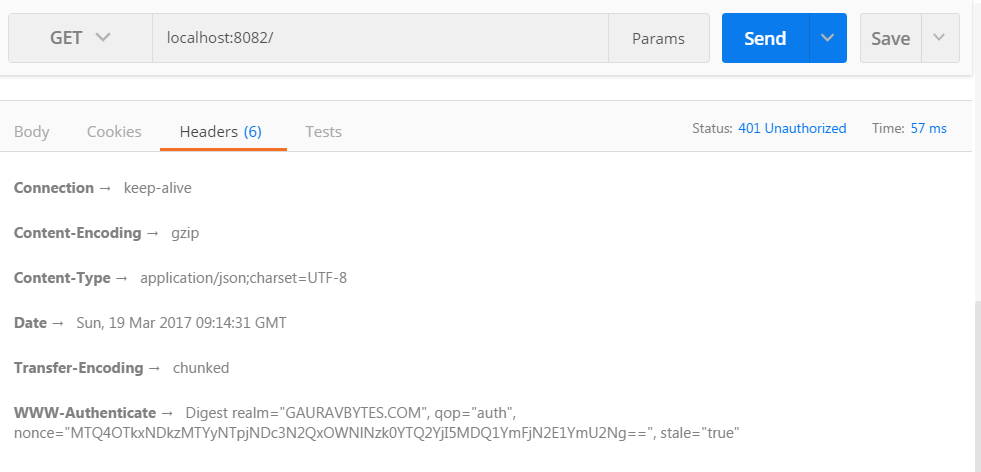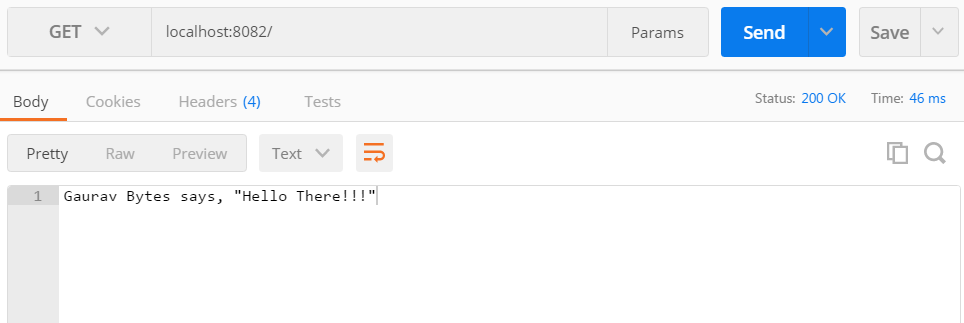Spring Security - How to use Digest Authentication?
We will start with What Digest Authentication is and then do project setup and run the example using postman.
1. What is Digest Authentication?
- This authentication method makes use of a hashing algorithms to encrypt the password (called password hash) entered by the user before sending it to the server. This, obviously, makes it much safer than the basic authentication method, in which the user’s password travels in plain text (or base64 encoded) that can be easily read by whoever intercepts it.
- There are many such hashing algorithms in java also, which can prove really effective for password security such as MD5, SHA, BCrypt, SCrypt and PBKDF2WithHmacSHA1 algorithms.
- Please remember that once this password hash is generated and stored in database, you can not convert it back to original password. Each time user login into application, you have to regenerate password hash again, and match with hash stored in database. So, if user forgot his/her password, you will have to send him a temporary password and ask him to change it with his new password. Well, it’s common trend now-a-days.
Let's start building simple Spring Boot application with Digest Authentication using Spring Security.
2. Project setup
We will use spring-boot-starter-security as maven dependency for Spring Security.
<dependency>
<groupId>org.springframework.boot</groupId>
<artifactId>spring-boot-starter-security</artifactId>
</dependency>3. Digest Authentication related Java Configuration
@Bean
DigestAuthenticationFilter digestFilter(DigestAuthenticationEntryPoint digestAuthenticationEntryPoint, UserCache digestUserCache, UserDetailsService userDetailsService) {
DigestAuthenticationFilter filter = new DigestAuthenticationFilter();
filter.setAuthenticationEntryPoint(digestAuthenticationEntryPoint);
filter.setUserDetailsService(userDetailsService);
filter.setUserCache(digestUserCache);
return filter;
}
@Bean
UserCache digestUserCache() throws Exception {
return new SpringCacheBasedUserCache(new ConcurrentMapCache("digestUserCache"));
}
@Bean
DigestAuthenticationEntryPoint digestAuthenticationEntry() {
DigestAuthenticationEntryPoint digestAuthenticationEntry = new DigestAuthenticationEntryPoint();
digestAuthenticationEntry.setRealmName("BLOG.GAURAV.CC");
digestAuthenticationEntry.setKey("Sup3rSecret");
digestAuthenticationEntry.setNonceValiditySeconds(60);
return digestAuthenticationEntry;
}You need to register DigestAuthenticationFilter in your spring context. DigestAuthenticationFilter requires DigestAuthenticationEntryPoint and UserDetailsService to authenticate user.
The purpose of the DigestAuthenticationEntryPoint is to send the valid nonce back to the user if authentication fails or to enforce the authentication.
The purpose of UserDetailsService is to provide UserDetails like password and list of role for that user. UserDetailsService is an interface. I have implemented it with DummyUserDetailsService which loads every passed userName's details. But, you can restrict it to some few user or make it Database backed. One thing to remember is the password passed need to be in plain text format here. You can also use InMemoryUserDetailsManager for storing handful of user configured either through Java configuration or with xml based configuration which could access your application.
In the example, I also have used the caching for UserDetails. I have used SpringBasedUserCache and underlying cache is ConcurrentMapCache. You can use any other caching solution of your choice.
3. Running the example
You can download the example code from Github. I will be using Postman to run the example. Here are the few steps you need to follow.
- Open postman and enter url (
localhost:8082). - Click on Authorization tab below the url and select Digest Auth from Type dropdown.
- Enter username(gaurav), realm(BLOG.GAURAV.CC), password(pwd), algorithm(MD5) and leave nonce as empty. Click Send button.
- You will get 401 unauthorized as response like below.

- If you see the Headers from the response, you will see
WWW-Authenticateheader. Copy the value of nonce field and enter in the nonce textfield. - Click on Send Button. Voila!!! You got the valid response.

This is how we implement Digest Authentication with Spring Security. I hope you find this post informative and helpful.
Tags: Spring Framework, Spring Security, Spring Boot, Spring Security Digest Authentication example, Digest Authentication Example
← Back home